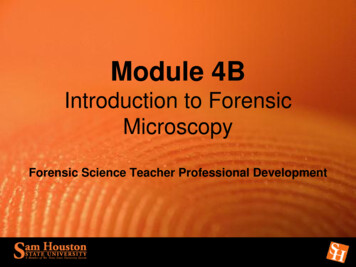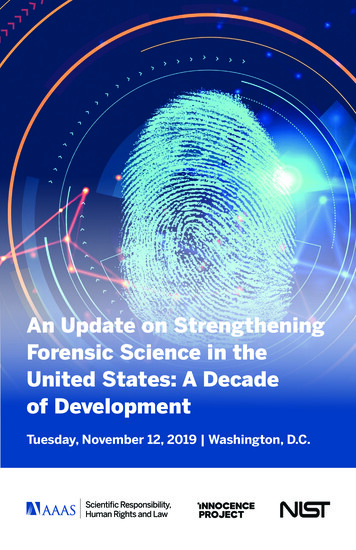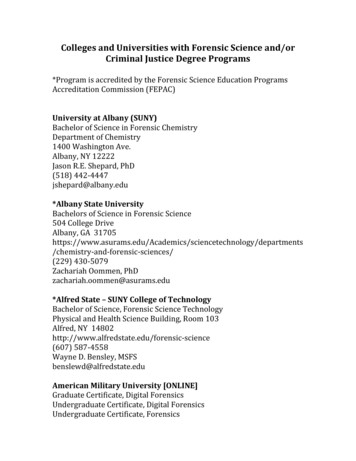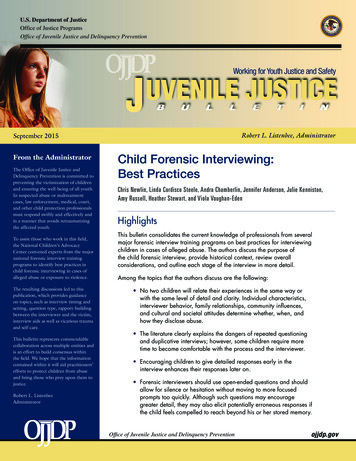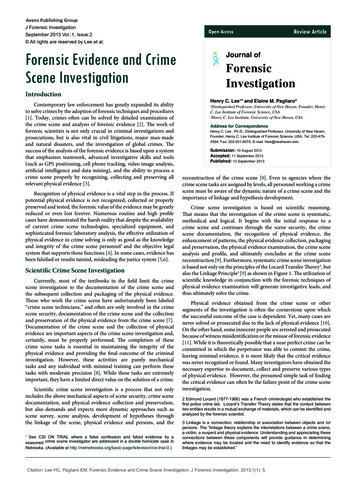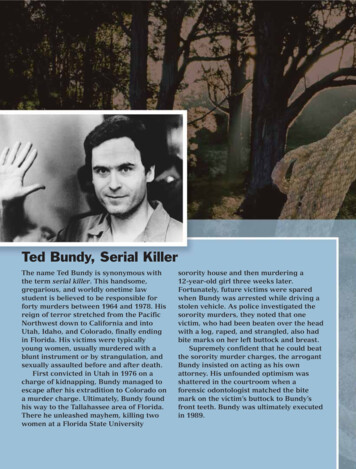
Transcription
Continue
Criminalistics an introduction to forensic science richard safersteinRichard Saferstein, Ph.D., retired after serving 21 years as the chief forensic scientist of the New Jersey State Police Laboratory, one of the largest crime laboratories in the United States. He currently acts as a consultant for attorneys and the media in the area of forensic science. During the O. J.Simpson criminal trial, Dr. Saferstein provided extensive commentary on forensic aspects of the case for the Rivera Live show, the E! television network, ABC radio, and various radio talk shows. Dr. Saferstein holds degrees from the City College of New York and earned his doctorate degree in chemistryin 1970 from the City University of New York. From 1972 to 1991, he taught an introductory forensic science course in the criminal justice programs at the College of New Jersey and Ocean County College. These teaching experiences played an influential role in Dr. Safersteinâ s authorship in 1977 ofthe widely used introductory textbook Criminalistics: An Introduction to Forensic Science, currently in this twelfth edition. Safersteinâ s basic philosophy in writing Criminalistics is to make forensic science understandable and meaningful to the nonscience reader, while giving the reader an appreciationfor the scientific principles that underlie the subject. Dr. Saferstein has authored or co-authored more than 45 technical papers and chapters covering a variety of forensic topics. Dr. Saferstein has co-authored Lab Manual for Criminalistics (Pearson, 2015) to be used in conjunction with this text. He is alsothe author of Forensic Science: An Introduction (Pearson, 2008 and 2011) and Forensic Science: From the Crime Scene to the Crime Lab (2009 and 2015). He has also edited the widely used professional reference books Forensic Science Handbook, Volumes I, II, and III, 2nd edition (published in 2002,2005, and 2010, respectively, by Pearson). Dr. Saferstein is a member of the American Chemical Society, the American Academy of Forensic Sciences, the Canadian Society of Forensic Scientists, the International Association for Identification, the Northeastern Association of Forensic Scientists, and theSociety of Forensic Toxicologists. He is the recipient of the American Academy of Forensic Sciences 2006 Paul L. Kirk Award for distinguished service and contributions to the field of criminalistics. The world’s #1 eTextbook reader for students. VitalSource is the leading provider of online textbooks andcourse materials. More than 15 million users have used our Bookshelf platform over the past year to improve their learning experience and outcomes. With anytime, anywhere access and built-in tools like highlighters, flashcards, and study groups, it’s easy to see why so many students are going digitalwith Bookshelf. File loading please wait. CRIMINALISTICS AN INTRODUCTION TO FORENSIC SCIENCE NINTH EDITION RICHARD SAFERSTEIN, Ph.D. Forensic Science Consultant, Mt. Laurel, New Jersey Lecturer, Widener University School of Law Upper Saddle River, New Jersey 07458 Libraryof Congress Cataloging-in-Publication Data Saferstein, Richard, (date) Criminalistics: an introduction to forensic science / Richard Saferstein. — 9th ed. p. cm. Includes index. ISBN 0-13-221655-8 1. Criminal investigation. 2. Forensic ballistics. 3. Chemistry, Forensic. 4. Medical jurisprudence. I. Title.HV8073.S2 2007 363.25—dc22 2005056485 1 Editor-in-chief: Vernon R. Anthony Executive Editor: Frank Mortimer, Jr. Assistant Editor: Mayda Bosco Marketing Manager: Adam Kloza Editorial Assistant: Jillian Allison Production Editor: Linda Zuk Production Liaison: Barbara Marttine Cappuccio Directorof Manufacturing and Production: Bruce Johnson Managing Editor: Mary Carnis Manufacturing Manager: Ilene Sanford Manufacturing Buyer: Cathleen Petersen Senior Design Coordinator: Mary Siener Interior Design: Pronk and Associates Cover Designer: Jonathan Boylan Cover Images: DNA strand,Chad Baker, Getty Images; Footprints, Alan Polansky: Broken glass: K. Hackenberg/zefa/Corbis; Fiber, Graeme Montgomery, Getty Images. Director, Image Resource Center: Melinda Patelli Manager, Rights and Permissions: Zina Arabia Manager, Visual Research: Beth Brenzel 2 Manager, CoverVisual Research & Permissions: Karen Sanatar Image Permission Coordinator: Richard Rodrigues Photo Researcher: Melinda Alexander Media Editor: John J. Jordan Manager of Media Production: Amy Peltier Media Production Project Manager: Lisa Rinaldi Formatting: Carlisle Publishing ServicesPrinting and Binding: R.R. Donnelley & Sons, Willard, Ohio Cover Printer: Lehigh Press Copyright 2007, 2004, 2001, 1998, 1995, 1990, 1987, 1981, 1977 by Pearson Education, Inc., Upper Saddle River, New Jersey, 07458. Pearson Prentice Hall. All rights reserved. Printed in the United States ofAmerica. This publication is protected by Copyright and permission should be obtained from the publisher prior to any prohibited reproduction, storage in a retrieval system, or transmission in any form or by any means, electronic, mechanical, photocopying, recording, or likewise. For information regardingpermission(s), write to: Rights and Permissions Department. Pearson Prentice Hall is a trademark of Pearson Education, Inc. Pearson is a registered trademark of Pearson plc Prentice Hall is a registered trademark of Pearson Education, Inc. Pearson Education LTD. Pearson Education AustraliaPTY, Limited 3 Pearson Education Singapore, Pte. Ltd Pearson Education North Asia Ltd Pearson Education, Canada, Ltd Pearson Educación de Mexico, S.A. de C.V. Pearson Education–Japan Pearson Education Malaysia, Pte. Ltd 10 9 8 7 6 5 4 3 2 1 ISBN 0-13-221655-8 ISBN 0-13-222710-X To theMemory of Fran and Michael Criminalistics Now Accompanied by DNA Evidence CD-ROMs A feature of this edition of Criminalistics is two CD-ROMs. One of the difficulties that instructors of forensic science have encountered in the past was how to bring the student reader to the crime scene. Therecognition and proper collection of physical evidence at the crime scene is an integral part of forensic science. Yet because of the elaborate classroom preparation required, the task of enabling the student to experience a mock crime scene is not feasible for most instructors. The U.S. Department ofJustice has helped to rectify this problem by creating a series of virtual crime scenes. In the words of the National Criminal Justice Reference Service: “The two CD-ROMs present training modules that provide students with interactive training on the basic information about the identification, preservation,and collection of DNA evidence at a crime scene. “The tutorial module presents best practices based on the work of the Crime Scene Investigation Working Group of the National Commission on the Future of DNA Evidence. The Commission was established by the Attorney General to achieve maximumusefulness of DNA evidence 4 in the criminal justice system. The module presents background information regarding DNA evidence and its use. It also presents interactive scenarios in which the first responding officer, investigating officer and/or evidence technician make choices regarding the handlingof crime scenes and evidence collection related to homicide, sexual assault, burglary, and violent crime. The training modules also include tests that last 20–30 minutes, a glossary, and 15 references.” Contents Preface xiii About the Author xvi Chapter 1 Introduction 2 Definition and Scope of ForensicScience 4 History and Development of Forensic Science 5 Organization of a Crime Laboratory 10 Services of the Crime Laboratory 13 Functions of the Forensic Scientist 16 Other Forensic Science Services 21 Chapter Summary 25 Review Questions 26 Further References 28 5 Case Study: Detection ofCurare in the Jascalevich Murder Trial 29 Chapter 2 The Crime Scene 36 Processing the Crime Scene 38 Legal Considerations at the Crime Scene 55 Chapter Summary 56 Review Questions 57 Further References 58 Case Study: The Enrique Camarena Case: A Forensic Nightmare 59 Chapter 3Physical Evidence 68 Common Types of Physical Evidence 70 The Significance of Physical Evidence 72 Forensic Databases 79 Crime Scene Reconstruction 83 Chapter Summary 84 Review Questions Further References 86 86 6 Case Study: Fiber Evidence and the Wayne William Trial 87 Chapter 4Physical Properties: Glass and Soil 98 The Metric System 100 Physical Properties 102 Comparing Glass Fragments 109 Glass Fractures 116 Collection and Preservation of Glass Evidence 118 Forensic Characteristics of Soil 119 Collection and Preservation of Soil Evidence 122 Chapter Summary 123Review Questions 124 Further References 125 Chapter 5 Organic Analysis 126 Elements and Compounds 128 Selecting an Analytical Technique 132 Chromatography 133 7 Spectrophotometry 144 Mass Spectrometry 150 Chapter Summary 154 Review Questions 155 Further References 157 Chapter6 Inorganic Analysis 158 Evidence in the Assassination of President Kennedy 162 The Emission Spectrum of Elements 164 Atomic Absorption Spectrophotometer 167 The Origin of Emission and Absorption Spectra 169 Neutron Activation Analysis 171 X-Ray Diffraction 174 Chapter Summary 175Review Questions 176 Further References 177 Chapter 7 The Microscope 178 8 The Compound Microscope 182 The Comparison Microscope 184 The Stereoscopic Microscope 186 The Polarizing Microscope 188 The Microspectrophotometer 189 The Scanning Electron Microscope (SEM) 192 ChapterSummary 195 Review Questions 196 Further References 197 Case Study: Microscopic Trace Evidence—The Overlooked Clue 198 Chapter 8 Hairs, Fibers, and Paint 206 Morphology of Hair 208 Identification and Comparison of Hair 212 Collection and Preservation of Hair Evidence 218 Types of Fibers219 Identification and Comparison of Manufactured Fibers 224 Collection and Preservation of Fiber Evidence 231 9 Forensic Examination of Paint 232 Collection and Preservation of Paint Evidence 239 Chapter Summary 242 Review Questions 243 Further References 245 Chapter 9 Drugs 246 DrugDependence 248 Narcotic Drugs 251 Hallucinogens 254 Depressants 259 Stimulants 260 Club Drugs 263 Anabolic Steroids 264 Drug-Control Laws 265 Drug Identification 268 Collection and Preservation of Drug Evidence 273 Chapter Summary 274 10 Review Questions 275 Further References 277Chapter 10 Forensic Toxicology 278 Toxicology of Alcohol 281 The Role of the Toxicologist 297 Techniques Used in Toxicology 298 The Significance of Toxicological Findings 302 The Drug Recognition Expert 303 Chapter Summary 306 Review Questions 307 Further References 309 Chapter 11Forensic Aspects of Arson and Explosion Investigations 310 The Chemistry of Fire 312 Searching the Fire Scene 318 Collection and Preservation of Arson Evidence 321 Analysis of Flammable Residues 323 11 Types of Explosives 327 Collection and Analysis of Explosives 332 Chapter Summary 340Review Questions 341 Further References 342 Chapter 12 Forensic Serology 344 The Nature of Blood 347 Immunoassay Techniques 350 Forensic Characterization of Bloodstains 352 Stain Patterns of Blood 359 Principles of Heredity 364 Forensic Characterization of Semen 367 Collection of RapeEvidence 371 Chapter Summary 376 Review Questions 377 Further References 379 Chapter 13 12 DNA: The Indispensable Forensic Science Tool 380 What Is DNA? 382 DNA at Work 385 Replication of DNA 387 Recombinant DNA: Cutting and Splicing DNA 388 DNA Typing 390 Mitochondrial DNA403 The Combined DNA Index System (CODIS) 410 Collection and Preservation of Biological Evidence for DNA Analysis 411 Chapter Summary 417 Review Questions 418 Further References 420 Case Study: The Forensic Community’s Response to September 11 421 Chapter 14 Fingerprints 426History of Fingerprinting 428 Fundamental Principles of Fingerprints 430 Classification of Fingerprints 435 13 Automated Fingerprint Identification Systems 436 Methods of Detecting Fingerprints 440 Preservation of Developed Prints 451 Digital Imaging for Fingerprint Enhancement 452 Chapter Summary454 Review Questions 455 Further References 457 Chapter 15 Firearms, Tool Marks, and Other Impressions 458 Bullet Comparisons 460 Cartridge Cases 467 Automated Firearms Search Systems 468 Gunpowder Residues 471 Primer Residues on the Hands 475 Serial Number Restoration 478Collection and Preservation of Firearms Evidence 479 Tool Marks 481 Other Impressions 484 14 Chapter Summary 492 Review Questions 493 Further References 494 Chapter 16 Document and Voice Examination 496 Handwriting Comparisons 498 Collection of Handwriting Exemplars 501 TypescriptComparisons 502 Photocopier, Printer, and Fax Examination 504 Alterations, Erasures, and Obliterations 505 Other Document Problems 510 Voice Examination 515 Chapter Summary 519 Review Questions 520 Further References 521 Chapter 17 Computer Forensics BY ANDREW W. DONOFRIO 522From Input to Output: How Does the Computer Work? 525 15 Putting It All Together 529 How Data Is Stored 530 Processing the Electronic Crime Scene 532 Evidentiary Data 536 Chapter Summary 544 Review Questions 544 Further References 545 Case Study 1: Computer Forensic Analysis Answersthe Question “Arson or Accident?” 546 Case Study 2: Counterfeiting and Fraud: A Forensic Computer Investigation 548 Chapter 18 Forensic Science and the Internet 550 What Is the Internet? 552 Where to Go on the Internet 555 Exploring Forensic Science on the World Wide Web 561 Websites YouMay Wish to Explore 563 Forensic Analysis of Internet Data 564 Forensic Investigation of Internet Communications 566 Hacking 569 16 Chapter Summary 570 Review Questions 571 Further References 571 Chapter 19 The Future 572 CASE READINGS 581 APPENDIXES I Guides to the Collection ofPhysical Evidence—FBI 611 II Instructions for Collecting Gunshot Residue (GSR) 627 III Chromatographic and Spectrophotometric Parameters for Figures Contained in the Text 627 IV Chemical Formulas for Latent Fingerprint Development 630 V Chemical Formulas for Development of FootwearImpressions in Blood 635 ANSWERS 639 INDEX 643 PHOTO CREDITS 653 Preface The ninth edition of Criminalistics has a new look. Wider margins along with color photographs and figures have been incorporated into the book’s design. A new chapter on computer forensics 17 has been added.What has not changed is the basic aim of the book: to make the subject of forensic science comprehensible to a wide variety of readers who are or plan to be aligned with the forensic science profession, as well as to those who are curious about the subject’s underpinnings. Many readers of this book havebeen drawn to the subject by the assortment of television shows that are based on it. Story lines depicting the crime-solving abilities of forensic scientists have excited the imagination of the general public. Perhaps we can attribute our obsession with forensic science to the yearnings of a society bent onapprehending criminals but desirous of a system of justice that ensures the correctness of its verdicts. The level of sophistication that forensic science has brought to criminal investigations is awesome. But one cannot lose sight of the fact that, once one puts aside all the drama of a forensic science case,what remains is an academic subject emphasizing logic and technology. It is to this end that the ninth edition of Criminalistics is dedicated. Criminalistics strives to make the technology of the modern crime laboratory clear and comprehensible to the nonscientist. The nature of physical evidence is defined,and the limitations that technology and current knowledge impose on its individualization and characterization are examined. By combining case stories with applicable technology, Criminalistics endeavors to capture the pulse and fervor of forensic science investigations. One of the constants of forensicscience is how frequently its applications become front-page news. Whether the story is of sniper shootings or the tragic consequences of the terrorist attacks of September 11, 2001, forensic science is at the forefront of the public response. The horror of the terrorist attacks exemplified the critical roleDNA has come to play in identifying victims of mass disaster. In this new century, the science of DNA profiling has altered the complexion of criminal investigation. DNA collected from saliva on a cup or from dandruff or sweat on a hat 18 exemplifies the emergence of nontraditional forms of evidencecollection at crime scenes. The criminal justice system is creating vast DNA data banks designed to snare the criminal who is unaware of the consequence of leaving the minutest quantity of biological material behind at a crime scene. During the highly publicized O. J. Simpson criminal and civil trials,forensic scientists systematically placed Simpson at the crime scene through DNA analyses, hair and fiber comparisons, and footwear impressions. As millions of Americans watched the case unfold, they, in a sense, became students of forensic science. Intense media coverage of the crime-scene searchand investigation, as well as the ramifications of findings of physical evidence at the crime scene, all became the subject of study, commentary, and conjecture. For those of us who have taught forensic science in the classroom, it comes as no surprise that forensic science can grab and hold the attentionof those who otherwise would have no interest in any area of science. The O. J. Simpson case amply demonstrates how intertwined criminal investigation has become with forensic science. Through nine editions, Criminalistics has striven to depict the role of the forensic scientist in the criminal justicesystem. The current edition builds on the content of its predecessors and updates the reader on the latest technologies available to crime laboratory personnel. Like all facets of modern life, forensic science has been touched by the computer and the Internet. This new edition introduces the reader tobasic computer technologies and concepts relied on during the forensic investigation of crimes. Retrieval of computerized information thought to be lost or erased is explored, as is the investigation of hacking incidents. Exploration of web sites particularly relevant to forensic science and criminalinvestigation is emphasized. 19 A major portion of the text centers on discussions of the common items of physical evidence encountered at crime scenes. These chapters include descriptions of forensic analysis, as well as updated techniques for the proper collection and preservation of evidence atcrime scenes. Particular attention is paid to the meaning and role of probability in interpreting the evidential significance of scientifically evaluated evidence. The implications of DNA profiling are important enough to warrant their inclusion in a separate chapter in Criminalistics. The topic of DNA isdescribed in a manner that is comprehensible and relevant to readers who lack a scientific background. The discussion defines DNA and explains its central role in controlling the body’s chemistry. Finally, the chapter explains the process of DNA typing and illustrates its application to criminalinvestigations through the presentation of actual case histories. The content of Criminalistics is a reflection of the author’s experience both as an active forensic scientist and as an instructor of forensic science at the college level. No prior knowledge of scientific principles or techniques is assumed of thereader. The areas of chemistry and biology relating to the analysis of physical evidence are presented with a minimum of scientific terminology and equations. The discussion involving chemistry and biology is limited to a minimum core of facts and principles that will make the subject mattercomprehensible and meaningful to the nonscientist. Although it is not the intent of this book to make scientists or forensic experts of readers, it will certainly be gratifying if the book motivates some students to seek further scientific knowledge and perhaps direct their education toward a career in forensicscience. Although Criminalistics is an outgrowth of a one-semester course offered as part of a criminal justice program at many New Jersey colleges, its subject matter is not limited to the college student. Optimum utilization of crime laboratory services requires that criminal investigators 20 have aknowledge of the techniques and capabilities of the laboratory that extends beyond any summary that may be gleaned from departmental brochures dealing with the collection and packaging of physical evidence. Only by combining a knowledge of the principles and techniques of forensic science withlogic and common sense will the investigator gain comprehensive insight into the meaning and significance of physical evidence and its role in criminal investigations. Forensic science begins at the crime scene. If the investigator cannot recognize, collect, and package evidence properly, no amount ofequipment or expertise will salvage the situation. Likewise, there is a dire need to bridge the “communication gap” among lawyers, judges, and the forensic scientist. An intelligent evaluation of the scientist’s data and any subsequent testimony again depends on familiarity with the underlying principles offorensic science. Too many practitioners of the law profess ignorance of the subject or attempt to gain a superficial understanding of its meaning and significance only minutes before meeting the expert witness. It is hoped that the book will provide a painless route to comprehending the nature of thescience. In order to merge theory with practice, a number of actual forensic case histories are included in the text. The intent is for these illustrations to move forensic science from the domain of the abstract into the real world of criminal investigation. Acknowledgments I am most appreciative of thecontribution that Detective Sergeant Andrew (Drew) Donofrio of New Jersey’s Bergen County Prosecutor’s Office made to this new edition of Criminalistics. I was fortunate to find in Drew a contributor who not only possesses extraordinary skill, knowledge, and hands-on experience with computerforensics, but was able to combine those attributes 21 with sophisticated communication skills. Sarah A. Skorupsky-Borg, MSFS, invested an extraordinary amount of time and effort in preparing an accompanying supplement to this edition: Basic Laboratory Exercises for Forensic Science. Her skills andtenacity in carrying out this task are acknowledged and greatly appreciated. Many people provided assistance and advice in the preparation of this book. Many faculty members, colleagues, and friends have read and commented on various portions of the text. Particular thanks go to the following peoplefor their critical reading and discussions of the manuscript: Norman Demeter, John Lintott, Charles Midkiff, Raymond Murray, and Richard Tidey. In addition, I would like to acknowledge the contributions of Jeffrey C. Kercheval, Robert Thompson, Roger Ely, Jose R. Almirall, Darlene Brezinski, MichaelMalone, and Ray Feldherr. The following reviewers provided insightful reviews and suggestions on this new edition: Professor John Kavanagh, Scottsdale Community College, Scottsdale, AZ; Professor Suzanne Montiel, Nash Community College, Rocky Mount, NC; Professor Walter F. Rowe; GeorgeWashington University; Wasington, D.C.; Professor David Tate, Purdue University, West Lafayette, IN; and Professor Sue Salem, Washburn University, Topeka, KS. The assistance of Pamela Cook and Gonul Turhan, whose research efforts are an integral part of this text, was invaluable. I am alsoappreciative of the time and talent given by Peggy Cole; development editor Mayda Bosco; and production editor Linda Zuk. I am grateful to the law enforcement agencies, government agencies, private individuals, and equipment manufacturers cited in the text for contributing their photographs andillustrations. Finally, I particularly wish to express my appreciation to Major E. R. Leibe (retired) and Major 22 V. P. O’Donoghue (retired) for their encouragement and support. Any author of a textbook must be prepared to contribute countless hours to the task, often at the expense of family obligations. Myefforts would have fallen well short of completion without the patience and encouragement of my wife Gail. Her typing and critical readings of the manuscript, as well as her strength of character under circumstances that were less than ideal, will always be remembered. Richard Saferstein, Ph.D. About theAuthor Richard Saferstein, Ph.D., retired in 1991 after serving twenty-one years as the Chief Forensic Scientist of the New Jersey State Police Laboratory, one of the largest crime laboratories in the United States. He currently acts as a consultant for attorneys and the media in the area of forensic science.During the O. J. Simpson criminal trial, Dr. Saferstein provided extensive commentary on forensic aspects of the case for the Rivera Live show, the E! television network, ABC radio, and various radio talk shows. Dr. Saferstein holds degrees from the City College of New York and earned his doctoratedegree in chemistry in 1970 from the City University of New York. From 1972 to 1991, he taught an introductory forensic science course in the criminal justice programs at the College of New Jersey and Ocean County College. These teaching experiences played an influential role in Dr. Saferstein’sauthorship in 1977 of the widely used introductory textbook Criminalistics: An Introduction to Forensic Science, currently in this ninth edition. Saferstein’s basic philosophy in writing Criminalistics is to make forensic science understandable and meaningful to the nonscience reader, while giving the readeran appreciation for the scientific principles that underlie the subject. 23 Dr. Saferstein currently teaches a course on the role of the expert witness in the courtroom at the law school of Widener University in Wilmington, Delaware. He has authored or co-authored more than forty-two technical paperscovering a variety of forensic topics. Dr. Saferstein has coauthored Lab Manual for Criminalistics (Prentice Hall, 2004). He has also edited the widely used professional reference books Forensic Science Handbook, Volume 1, 2nd edition (Prentice Hall, 2002), Forensic Science Handbook, Volume 2, 2ndedition (Prentice Hall, 2005), and Forensic Science Handbook, Volume 3 (Prentice Hall, 1993). Dr. Saferstein is a member of the American Chemical Society, the American Academy of Forensic Sciences, the Forensic Science Society of England, the Canadian Society of Forensic Scientists, theInternational Association for Identification, the Mid-Atlantic Association of Forensic Scientists, the Northeastern Association of Forensic Scientists, the Northwestern Association of Forensic Scientists, and the Society of Forensic Toxicologists. In 2006, Dr. Saferstein received the American Academy ofForensic Sciences Paul L.Kirk award for distinguished service and contributions to the field of criminalistics. CRIMINALISTICS 24 chapter 1 Introduction Key Terms algor mortis autopsy expert witness livor mortis Locard’s exchange principle rigor mortis Learning Objectives After studying this chapter youshould be able to: Define and distinguish forensic science and criminalistics Recognize the major contributors to the development of forensic science Account for the rapid growth of forensic laboratories in the past forty years Describe the services of a typical comprehensive crime laboratory in thecriminal justice system Compare and contrast the Frye and Daubert decisions relating to the admissibility of scientific evidence in the courtroom 1 Explain the role and responsibilities of the expert witness Understand what specialized forensic services, aside from the crime laboratory, are generallyavailable to law enforcement personnel Ted Bundy, Serial Killer The name Ted Bundy is synonymous with the term serial killer. This handsome, gregarious, and worldly onetime law student is believed to be responsible for forty murders between 1964 and 1978. His reign of terror stretched from thePacific Northwest down into California and into Utah, Idaho, and Colorado, finally ending in Florida. His victims were typically young women, usually murdered with a blunt instrument or by strangulation and sexually assaulted before and after death. First convicted in Utah in 1976 on a charge ofkidnapping, Bundy managed to escape after his extradition to Colorado on a murder charge. Ultimately, Bundy found his way to the Tallahassee area of Florida. There he unleashed mayhem killing two women at a Florida State University sorority house and then murdering a 12-year-old girl three weekslater. Fortunately, future victims were spared when Bundy was arrested while driving a stolen vehicle. As police investigated the sorority murders, they noted that one victim, who had been beaten over the head with a log, raped, and strangled, also had bite marks on her left buttock and breast. Supremelyconfident that he could beat the sorority murder charges, the arrogant Bundy insisted on acting as his own attorney. His unfounded optimism was shattered in the courtroom when a forensic odontologist matched the bite mark on the victim’s buttock to Bundy’s front teeth. Bundy was ultimately executed in1989. 2 DEFINITION AND SCOPE OF FORENSIC SCIENCE Forensic science in its broadest definition is the application of science to law. As our society has grown more complex, it has become more dependent on rules of law to regulate the activities of its members. Forensic science applies theknowledge and technology of science to the definition and enforcement of such laws. Each year, as government finds it increasingly necessary to regulate the activities that most intimately influence our daily lives, science merges more closely with civil and criminal law. Consider, for example, the lawsand agencies that regulate the quality of our
the author of Forensic Science: An Introduction (Pearson, 2008 and 2011) and Forensic Science: From the Crime Scene to the Crime Lab (2009 and 2015). He has also edited the widely used professional reference books Forensic Science Handbook, Volumes I, II, and III, 2nd edition (publishe



